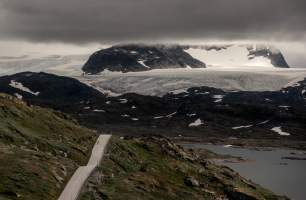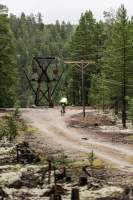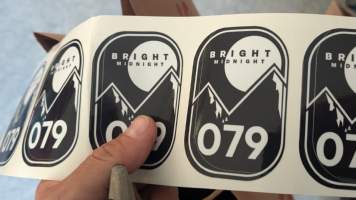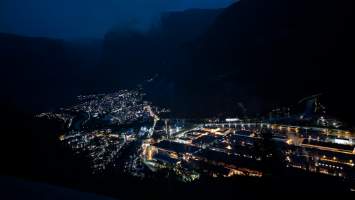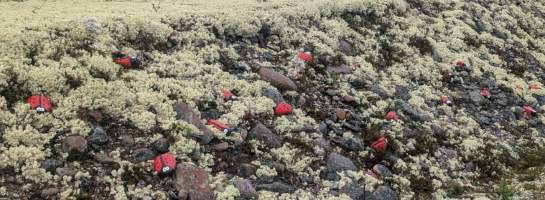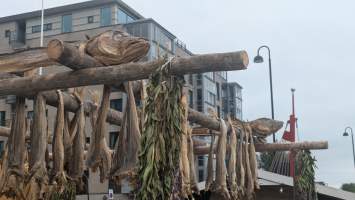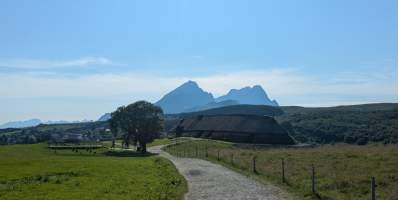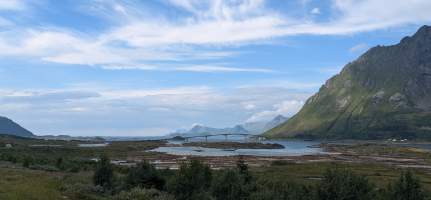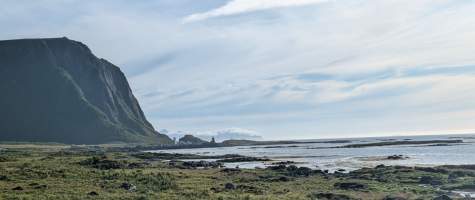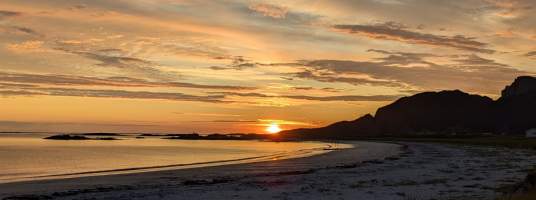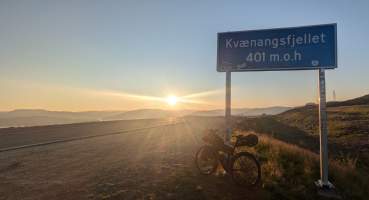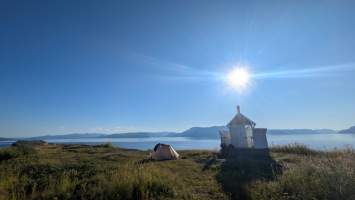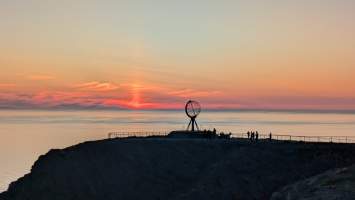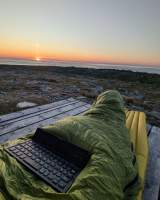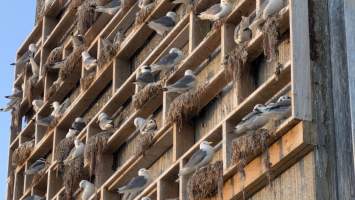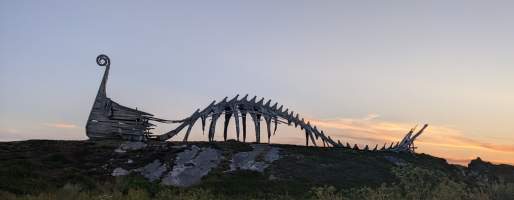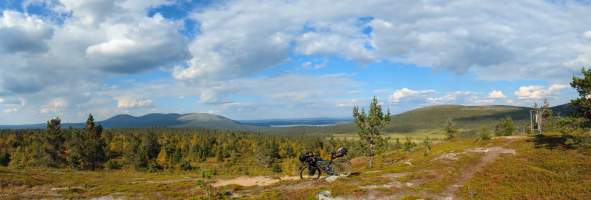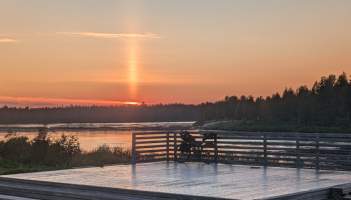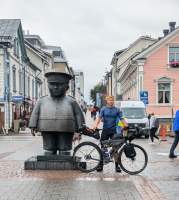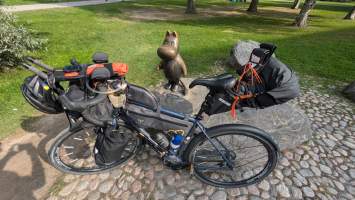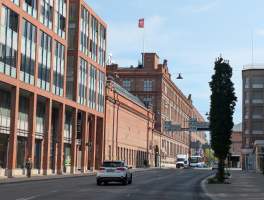The Route
A map of the route with the four legs – Bright Midnight, Lofoten, the Barents Sea and the return journey – color coded and split into daily sections.
A full map is available on UMAP. The individual segments, largely corresponding to daily rides, were:
- Part One: The Bright Midnight
- d01 Reaching Norway
- d02 Elverum to Dalsbygda (232 km distance, 2192 m elevation gain)
- d03 Dalsbygda – Tynset Loop (91 km, 534 m)
- d04 Dalsbygda – Tolga Loop (Registration) (52 km, 518 m)
- d05-09 The Bright Midnight 2024 (1109 km, 15645 m)
- Part Two: Lofoten
- d10 Bodø / Moskenes to Flakstad (44 km, 453 m)
- d11 Flakstad to Rystad (83 km, 738 m)
- d12 Rystad to Grunnfør (91 km, 910 m)
- d13 Grunnfør to Sortland (104 km, 970 m)
- d14 Sortland to Stave (91 km, 530 m)
- d15 Stave to Ersfjord (Senja) (72 km, 762 m)
- d16 Ersfjord to Kaldfjord (85 km, 856 m)
- d17 Kaldfjord to Tromsø (27 km, 196 m)
- d18 Tromsø
- d19 Narvik to Ballangen (53 km, 412 m)
- d20 Ballangen to Sørkil (58 km, 874 m)
- d21 Sørkil to Nes (45 km, 436 m)
- d22 Nes to Skutvik / Bodø (15 km, 89 m)
- Part Three: Barents Sea
- d23 Skjervøy to Storekorsnes (223 km, 2699 m)
- d24 Storekorsnes to Honningsvåg (222 km, 2020 m)
- d25 Nordkapp (67 km, 1253 m)
- d26 Mehamn to Slettnes (38 km, 538 m)
- d27 Slettnes to Skiippagurra (219 km, 2860 m)
- d28 Skiippagurra to Vardo (159 km, 991 m)
- Part Four: Finland
- d29 Kirkenes to Lake Inari (191 km, 1406 m)
- d30 Lake Inari to Karasjok (101 km, 755 m)
- d31 Karasjok to Hetta (214 km, 1489 m)
- d32 Hetta to Kolari (191 km, 1307 m)
- d33 Kolari to Rovaniemi (164 km, 971 m)
- d34 Rovaniemi to Oulu (233 km, 765 m)
- d35 Oulu to Vihanti (96 km, 344 m)
- d36 Vihanti to Vimpeli (219 km, 825 m)
- d37 Vimpeli to Virrat (113 km, 561 m)
- d38 Virrat to Tampere (113 km, 846 m)
- d39 Tampere to Turku (188 km, 1061 m)
- d40 Stockholm (20 km, 171 m)
All in all the longest tour I ever did, both in terms of total distance and in days spent in the saddle.
Summary
This quadripartite second Nordic expedition took me up the highest mountains of Norway, along the most scenic coastline north of the arctic circle, to the nothernmost points of Europe, and back south through the endless tundra of Finland.
In total, this voyage covered 5069 km on the bicycle, 1100 km of that as part of the Bright Midnight route, and climbed 47100 m. Over 37 days I averaged 137 km of distance and climbed 1270 m every day – a rather sustainable effort, certainly less brutal than last year’s mountainous adventure in Spain. Still, considering its highest point was Sognefjellet with “only” 1428 m of elevation and it contains more than a week of almost flat Finland, the route was surprisingly climbing heavy after all.
Furthermore, with Sweden and Finland I checked two more entries of the list of countries visited. Especially Finland I regretted not visiting ealier. And I got very close to Russia too though I don’t have any intention to enter that place in the foreseeable future.
Part One: Bright Midnight
The first leg consisted of the Bright Midnight, a bikepacking ultra race organized by legend Justinas Leveika that takes place every year in and around Jotunheimen national park. Starting in the minute town of Tolga we, that is about 150 cyclists, rode a loop of 1100 km on paved and gravel roads that incorporates some of the most arduous climbs, fierce mountain tundra climate and challenging hike-a-bikes.
Food supply was a continuous issue as the region is sparsely populated and a distance of 100 km or more between resupply points was not uncommon. All that in frequent rain and generally chilly temperatures. The scenery however was a reward in itself, it featured the whole palette from wild rivers and uncountable waterfalls, magical forests covered in reindeer moss, glaciers (!), feral animals and cunning trolls, steep ravines, tunnels, tunnels with loops in them, mountain panoramas, etc. etc. Not to mention the crowd, I didn’t get to know half of them but the ones I did chat with, all of them were unique and had something interesting to say.
Part Two: Lofoten, Tromsø, Narvik, Bodø
The second leg then was another loop, now north of the arctic circle. Starting and concluding in the enchanting town of Bodø it covered almost 1000 km of distance in the rugged Lofoten islands, through remote Vesterålen to the pristine beauty of Senja, and back on the southern bank of Ofotfjorden.
Finally most midnights were actually bright, even though it was late enough in the year for the sun to set; and in doing so it became a looming crimson fireball every day. Fjords, vikings, stockfish, boats, campervans – Lofoten again presented itself as the quintessential Norwegian experience. No pressure at all to even keep riding for a change so there was plenty of time to soak it all in. The weather too was unusually stable, quite different from my previous experiences cycling on those islands.
One of if not the best decision, it turned out, during the planning phase of this trip was to skip the wet, cold south of the country (except for the Bright Midnight, of course) and start the journey north of the arctic circle.
Part Three: the Barents Sea
Leg three first led me to the edge of Europe, or two edges of different definitions: firstly the northermost point of the continent reachable on a road at Nordkapp, and secondly the northernmost reachable point on the mainland at Slettnes. These days on the shores of the Barents See with always a reindeer in sight marked the uncontested highlights of the entire trip. In Vardø I ran out of road; no suprise, the island constitutes the eastermost point of Norway, further to the east than even St. Petersburg.
Part Four: Lappland and Finland
I crossed briefly into Finland near lake Inari only to return to Norway the next day en route to the Saami capital Karasjoki. From there on I was ever southbound: after re-entering Finland I took the Old Post Road till Rovaniemi, touched the Baltic Sea in Oulu, the cyclist heaven, then cut through the interior until I reached Tampere and headed back to the sea to Turku. There I embarked on a ferry to Stockholm where after half a day of sightseeing I concluded the trip.
Wind and Sun
The weather had already been nice on Lofoten but up north it became outright phenomenal. For weeks I enjoyed clear skies and the sun was shining 20+ hours per day. Only when I was closing in on southern Finland did the clouds come back, but even then it rained only occasionally. I really lucked out in that regard.
However I expected to gain more from the change in direction compared to 2022 as this time I went to the Kapp from the south-west to the north-east to follow the prevalent winds. Two years ago that would have worked, but in the 2024 summer it was futile because what caused the fantastic weather was also the reason for much of the headwind that I experienced regardless: the constant wind from the south-east that was blowing out of Finland and Russia, supplying the region with hot air and driving clouds away. That wind was the most annoying whenever I was going south, e. g. on the high plateaus I crossed between Slettnes and Ifjord, or in most of Finland. It could have been worse though, I certainly wouldn't have traded the headwind for bad overall weather.
Regarding Finland, I'm glad I had the time to continue all the way down to Turku. Despite the punctures I sustained on account of a worn tire it was an incredibly positive experience to get to spend some time in this amazing country and its natives. In fact it was mainly the larger towns that made the Finland leg of this voyage so rewarding. Oulu is still in my top three places I visited in this trip – see below –, perhaps even on par with Vardø; Tampere and Turku rank fairly high as well all things considered, with Rovaniemi just behind. And I barely scratched the surface of those places; I would go back to Finland in a heartbeat for a more complete experience.
The Weather
I got exceptionally lucky with the weather, there’s no denying that! However, the trip started out just as rainy as I remembered southern Norway from last time. It started raining in time for the start of the Bright Midnight and never completely stopped. North of the arctic circle, starting in Moskenes, the weather improved tremendously and it was blue skies and sun for days on end. The Troms region was on alert on account of the fire hazard posed by dried out bogs? I did not have that on my Norway bingo card.
On the Barents Sea it got surreal. Sleeping without a tent near Slettnes lighthouse I was nearly getting boiled alive in my three-season sleeping bag; I regretted bringing the damn heavy thing ever since the heat ruined my sleep that night down in Øvre Årdal. The excellent conditions lifted my spirits to new peaks; from Skjervøy to Kirkenes I rode through one uninterrupted episode of euphoria despite the exhaustion and sleep deprivation after long days in the saddle, crushing winds, and chilly temperatures at night.
Highlights
If I had to choose the three places I visited along the way that I was most excited about, this would be my list in order of appearance:
-
Grimsdalen and the “magic forest” that followed it. Part of the finale of the Bright Midnight it starts with a brutal climb that I was too fatigued to cycle up. From the pass however it’s all downhill through a strange valley with scant vegetation but stunning vistas that in the lower parts resemble Monument Valley.
-
Vardø and the entire Varangerfjord. The far end of mainland Norway, too remote even for most campervans. Where Saami and Norwegian culture intertwine. Vardø in particular, the turning point of the route, is a fascinating place with a rich history, pulling way above its weight in terms of sightseeing.
-
Finally, Oulu, the exemplary cycling town. On two wheels one immediately feels home in Oulu. One of the largest places I’ve passed through it boasts the densest and most extensive cycling infrastructure I’ve seen. Far above anything Germany has to offer, it compares very well even to Dutch cities too. Of the places I’ve seen personally it certainly is the benchmark. And of course, Toripolliisi is watching over it with his stern face.
These I wouldn’t hesitate to recommend to anyone, not just cyclists. They’re quite different from one another too and each is spectacular in its own right: a tundra covered valley in the mountains of the south, an island fortress at the far end of the country, and a vibrant city on the Bay of Bothnia.
There is no shortage of top candidates though. Some that instantly come to mind are Tunnelveien, Andøya, Sommarøya, Storekorsnes, Slettnes, the Old Post Road, Tampere, Turku. It’s telling that for Norway the list contains exclusively geographical points of interests but mostly settlements for Finland. The rough outdoors of the former contrast with extremely livable towns of the latter.
Final Thoughts
I was worried I might get bored by revisiting Norway. Back in 2022 I had seen parts of the Bright Midnight route – Sognefjellet and the Åndalsnes area – as well most of the segment from Bodø to Nordkapp. And let’s face it, especially in the north it’s not like there’s a huge number of alternative roads I could have taken. Usually there is none. But my worry was unfounded as I enjoyed every bit of these roads just as much as last time. The route was challenging and beautiful throughout with few exceptions, and even on long days in the saddle never failed to motivate. Settings like Tunnelveien, Slettnes and Vardø were inspiring, I expect the memory of these to last a long time.
And of course the concept phase for the next visit to Norway has already started.
